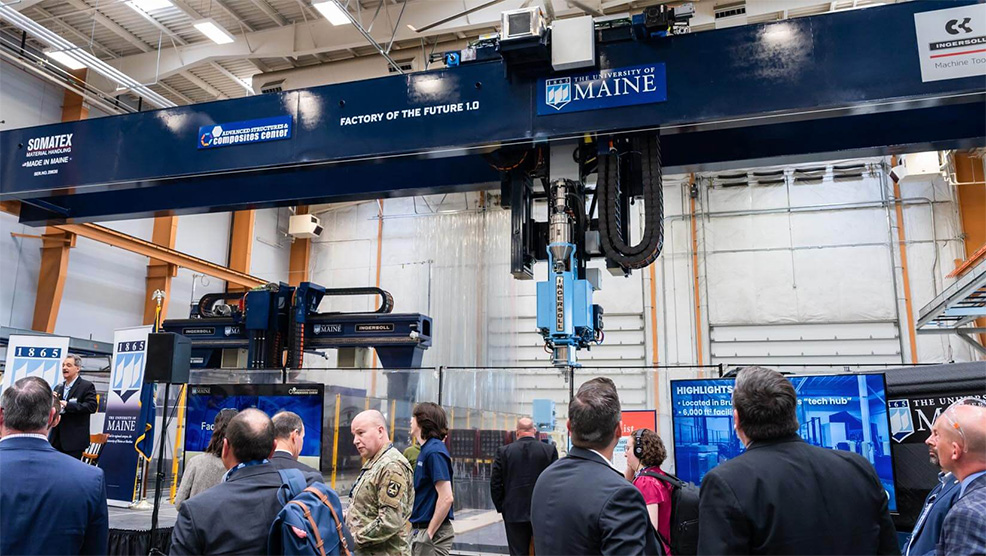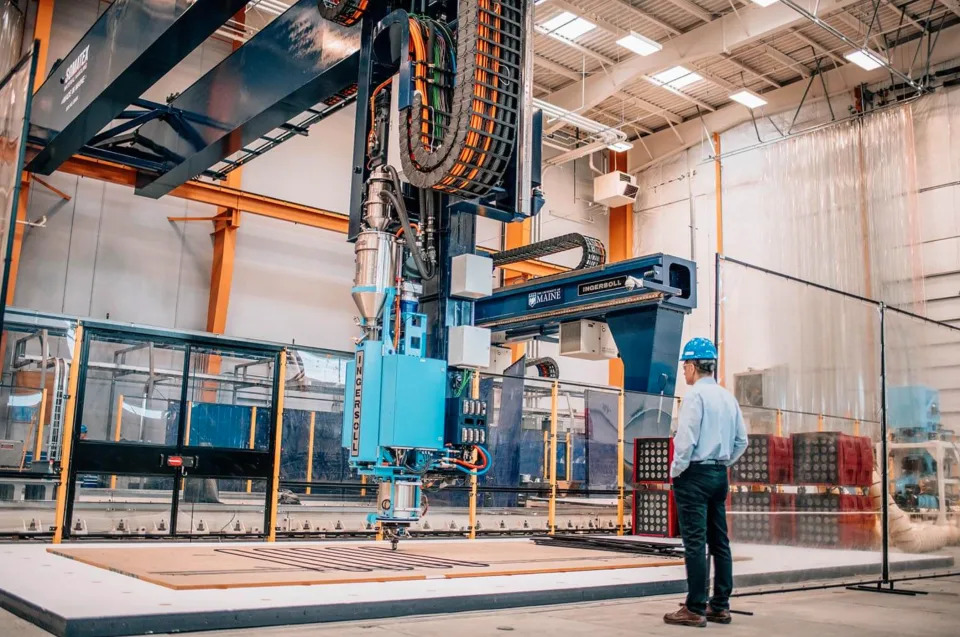
1st May 2024 Record-breaking 3D printer is four times larger than predecessor The University of Maine has demonstrated the world's largest 3D printer. Using thermoplastic polymers, the machine can print objects as large as 29 m (96 ft) long by 9.8 m (32 ft) wide by 5.5 m (18 ft) high, at a rate of 230 kg (500 lbs) per hour.
In the last decade, 3D printing has evolved from the fabrication of small, intricate objects to the construction of entire homes, bridges, boats, and other large structures like public art installations and even rockets bound for space. This rapid scale-up in capabilities has the potential to become a transformative shift in manufacturing and construction paradigms. Factory of the Future 1.0 (FoF 1.0), recently announced by the University of Maine (UMaine), is the largest ever 3D printer – quadruple the size of the previous record holder – and so large, in fact, that it could print an object the length of a blue whale. A presentation took place at UMaine's Advanced Structures and Composites Center (ASCC), with an audience that included representatives from the U.S. Department of Defense, U.S. Department of Energy, Maine State Housing Authority, industry partners and others who plan to utilise this technology. According to its creators, the FoF 1.0 provides new opportunities for eco-friendly and cost-effective manufacturing for numerous industries – including national security, affordable housing, bridge construction, ocean and wind energy technologies and maritime vessel fabrication. Costing several million dollars, the giant printer uses "sensors, high-performance computing and artificial intelligence," and "opens up new research frontiers to integrate robotics operations at a very large scale," said Habib Dagher, ASCC Executive Director.
The production and use of traditional materials such as cement, steel, and aluminium involve carbon-intensive processes, with buildings and their construction accounting for a massive 37% of global greenhouse gas emissions. By contrast, UMaine's project aims to show that homes can be constructed nearly entirely with a lower carbon footprint. It will help advance various initiatives, including the development of bio‑based feedstocks from wood residuals and commercialisation of sustainable housing projects. The ASCC's prototype BioHome3D, for example, became the first 3D‑printed house made with 100% wood fibres, wood insulation, and bio‑resins when demonstrated in 2022. "Maine needs an estimated 80,000 additional homes by 2030, many specifically for households with incomes at or below the area median income. This new technology allows UMaine-ASCC to scale-up its research and production of its innovative bio-based 3D printed home technology," said Mark Wiesendanger, MaineHousing's Development Director. "This effort creates another means of producing quality affordable housing, while further driving costs down, and using abundant wood residuals from Maine's sawmills. We look forward to continuing our collaboration with Dr. Dagher, the staff and students at UMaine/ASCC in demonstrating how 3D printed homes and other next-generation housing technologies will quickly and efficiently contribute to enhancing Maine's housing stock." The University of Maine is now planning a new research laboratory called the Green Engineering and Materials (GEM) Factory of the Future. This will house both FoF 1.0 and its smaller predecessor, MasterPrint. The two printers will be able to collaborate on projects and are expected to be joined by even larger 3D printers in the future.
Comments »
If you enjoyed this article, please consider sharing it:
|
||||||








